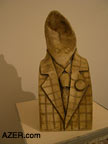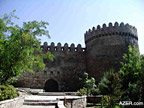|

Autumn 2004 (12.3)
Pages
32-37
Baku's Old City
Preserving Our Past
by Mir Teymur
  No doubt, there are
many times that Mir Teymur feels like he's "a voice, crying
in the wilderness"-a prophet of doom and gloom, who is not
fully appreciated by those who could benefit most by heeding
his dire warnings. No doubt, there are
many times that Mir Teymur feels like he's "a voice, crying
in the wilderness"-a prophet of doom and gloom, who is not
fully appreciated by those who could benefit most by heeding
his dire warnings.
Mir Teymur is a socially conscious artist and long-time resident
of Baku's "Ichari Shahar" ("Inner City",
or what the foreigners call "Old City"). He claims
that his ancestors have lived there for the past 800 years. As
a result, he lives and breathes this old sector of the city.
Most of his graphics and ceramics relate directly to Ichari Shahar.
Like so many of his contemporaries, Mir Teymur credits his grandmother
for the passion he feels about the Old City. Nargiz Hajinsky
would have been in her early 20s when Baku fell to the Bolsheviks
and her parents' wealth and property, including oil wells, were
confiscated. It was this woman who sensed the tremendous changes
that were occurring in the political structure of the nation.
It was she who suffered tremendous pain of losing so many of
her family members during Stalin's purges of 1937 when they were
executed. And so, today, it should come as no surprise that her
grandson Mir Teymur is the driving force behind the effort to
preserve Ichari Shahar historically.
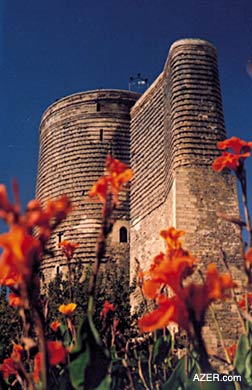  Left: Baku's most distinguished landmark,
Maiden Tower (Giz Galasi) believed by most to have been built
as a fortress and relay signaling system in the 12th century. Left: Baku's most distinguished landmark,
Maiden Tower (Giz Galasi) believed by most to have been built
as a fortress and relay signaling system in the 12th century.
There are so many things that are so dear to me about the Ichari
Shahar. I feel so connected to it. My family traces its roots
back to the 12th century when Baku was chosen as the residence
of the Shirvan Shahs. That makes us one of the oldest families
living here.
Sometimes I feel like I've studied every stone, every wall, every
building in this place. It makes me stand in awe of what our
forefathers knew and understood about town planning, both in
their attempts to guarantee the security for the community, and
in compensating for the harsh climactic conditions such as Baku's
ferocious winds and the sweltering summer heat.
Take the issue of security, for example. It seems that other
countries and other people have always cast a jealous eye towards
Baku, not only for our oil, but also for other natural resources
such as salt, silk and saffron. So we've always had to deal with
issues of security.
Baku is one of the very few cities in the world, which used to
be surrounded by three walls. Today, only one wall stands; the
outer two have been destroyed and the stone has been used in
the construction of homes. If you study the citadel wall carefully,
you'll see that they were designed to provide multi-layers of
defense. If the enemy succeeded in penetrating the outer walls,
which were not as tall as the final wall surrounding the city,
then the residents could shoot down at them from the round-shaped
lookout posts. If you look carefully, you'll see that in certain
segments of the wall there are holes where hot oil could be poured
down upon the enemy, burning and trapping them so that they would
be unable to escape back over the outer walls.
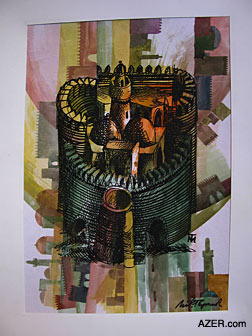  Left: Graphics: The Old City surrounded by
a citadel wall as fortress by artist Mir Teymur. Left: Graphics: The Old City surrounded by
a citadel wall as fortress by artist Mir Teymur.
If the enemy still succeeded in penetrating inside Ichari Shahar,
even the street plan was designed for defense. The streets seem
sufficiently wide enough for four horses to run abreast. But
rather quickly, they narrow so that the enemy would have to reduce
his speed and then the horses would have to follow behind each
other in single file. For the residents, this made it easier
for them to attack the intruder from the roofs of their homes.
And then there were the twists and turns in the lanes. Sometimes,
the streets ran clockwise; sometimes, counter-clockwise. Sometimes,
they led to dead-ends. It doesn't take long for people not accustomed
to Ichari Shahar to lose their bearings and become totally confused
and disoriented. But all these streets and alleyways were laid
out according to plan, not by mere chance and all these characteristics
contributed to the security of the community.
Even hostile climactic conditions were taken into consideration.
Baku experiences ferocious northern winds, but since the houses
were not laid out in straight grids, the intensity of the winds
can be somewhat dissipated.
The residents of Ichari Shahar also learned to compensate for
the sweltering summer heat by building houses with thick walls,
one-meter wide, which served as a cooling system. Even the shade
cast from buildings on either side of the narrow alleyways provided
relief from the direct rays of the sun.
The architecture was planned as an integrated whole which consciously
worked to benefit the entire community. But that's not the way
things work these days. The Ichari Shahar that we once knew is
disappearing right before our eyes. Already, irreparable damage
has been carried out that is likely never to be undone.
I write articles. I make speeches. I'm even in the process of
writing a book about the history of Ichari Shahar. I've been
fighting like this for the last 30 years. Sometimes I feel like
a lone prophet crying in the wilderness, because no one is heeding
my message: "Stop the destruction of our Inner City. Stop
the barbaric destruction of our history. This place embodies
the sacred core of our civilization. Let's preserve it for future
generations."
Illegal construction, the likes of which we are seeing these
days, did not take place during the Soviet period. At that time,
had I made a speech in the morning about the destruction that
is going on in Ichari Shahar, by evening the Secretary of the
District Committee would have been on the scene to investigate.
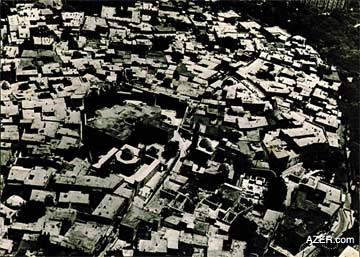  Left: Aerial view of Ichari Shahar: Soviet
Period Left: Aerial view of Ichari Shahar: Soviet
Period
It used to be that people were afraid to destroy any of the buildings
here in Ichari Shahar. During the Soviet period, officials feared
for their jobs if they granted someone permission to demolish
a building. It was easy to bring accusations in the newspapers
against someone for such an offense. So out of fear, Ichari Shahar
retained much of its medieval character.
Of course, it would have been better if people had acted out
of conscience, rather than fear, but these days, they act neither
out of fear nor conscience. Any building can be sold. In addition,
many people who live in Ichari Shahar who really want to continue
to live here are forced by poverty to sell their homes and move
away. When they leave, this, too, contributes to altering the
character of the neighborhood. Their absence is felt by those
of us who remain and it is a great loss to us. I don't have anything
against new people moving here, but I would like them to care
about Ichari Shahar and not destroy its history.
All this major construction has occurred since we gained our
independence in late 1991. How ironical that at the exact moment
in time when we have the best chance to safeguard our own national
history, we are contributing the most to its destruction.
Warsaw
The greatest problem is that these new buildings are destroying
the character and face of Ichari Shahar. It doesn't have to be
this way. Consider Poland and the city of Warsaw. Because of
extensive bombing in World War II, the city was reduced to rubble.
Despite the enormous devastation, the city has been rebuilt and,
today, stands as a very beautiful city and a tribute to the human
desire to maintain links to the past. This restoration came because
of the commitment of government officials who employed artists,
historians and architects to ensure that the rebuilding effort
was in accord with the old gravures and watercolor sketches,
which documented what the city center, had previously looked
like. Warsaw was reconstructed, thanks to their hard labor and
love.
Today when you visit Warsaw, you think that these buildings were
actually constructed in the 15th-16th centuries, but they are
20th century reconstructions. The face of Warsaw has been kept
because the Polish people were committed to keeping their own
history. Krakow was rebuilt in the same manner.
Above: Mir Teymur is known
for his protest art. Here he is biting satire and critique of
society are molded into clay. The artist depicts upon some of
the characters familiar to him growing up in Baku's Old City.
Left to right: 1. Too small for position 2. No personality 3.
Empty Brain 4. The Gossip
Ichari Shahar today
But so many of our new buildings do not complement the character
of Ichari Shahar. Take, for example, the British Council, a building
of many stories with its façade of glass. It has no place
in our Old City beside a medieval bathhouse.
And how is it that Embassies have been allowed to establish their
governmental offices in this part of our city that is historically
reserved for private residential quarters. Presently, Ichari
Shahar is host to the embassies of Italy, Norway, Georgia, Greece
and Poland. Even for the safety of diplomats in this new age,
it is not a wise decision to settle there because there are only
a few streets that exit Ichari Shahar.
From the early days of independence, commercial interests set
their eyes on Ichari Shahar to set up offices there. BP and Statoil
Alliance was the first oil company to move there. Then other
oil companies followed: Amoco, AIOC (Azerbaijan International
Operating Company), NAOC (North Absheron Operating Company),
Pennzoil (now Devon), LUKoil, Agip, Mobil and Ramco. Now most
of these companies have moved out or have been dissolved. These
oil companies came to realize that their fantasy of working in
the Old City was a bad management decision because it brought
so much vehicular traffic to those narrow streets. Simply, the
infrastructure could not effectively support their own operation.
Today, many of these major companies have relocated elsewhere;
unfortunately other companies have taken their places, including
major international financial institutions.
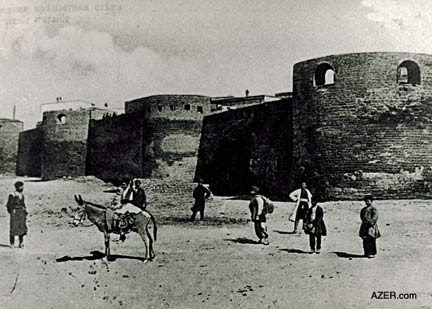  Left: Outside the Citadel walls, late 19th
century Left: Outside the Citadel walls, late 19th
century
I remember
when I was studying art in St. Petersburg (then Leningrad).
They had an excellent school where architects studied issues
related to historical restoration. Architects involved with the
design of buildings in Ichari Shahar must have a broad range
of knowledge and interests. In addition to architecture, they
should know the history, archaeology, ethnography and even folklore,
specific to this location as well. This land is a sacred, holy
place so it requires special sensitivities.
Not every person who has studied architecture should have the
right to design houses in the Ichari Shahar. Let them go to the
suburbs-the micro regions-where it doesn't matter as much if
they don't maintain the flavor and color of the past.
I'm not saying that construction should not take place in Ichari
Shahar. Not at all. There are many houses that are so old and
dilapidated. Such houses should be destroyed because they are
hazardous for people to live in. But the buildings which replace
them should be rebuilt in such a manner that they blend in with
the surrounding buildings. This is what is being done in St.
Petersburg. From the outside, buildings take on the appearance
and façade of the 17th or 18th century. Inside, the residents
enjoy every comfort of modern life: air-conditioning, heating,
lighting, design.
World Heritage
Site
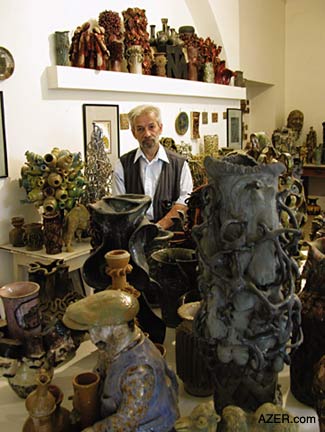  In December
2000, UNESCO's (United Nations Educational, Scientific and Cultural
Organization) World Heritage Committee added Baku's Ichari Shahar
to its list of World Heritage Sites. At the time, this designation
had been extended to 690 historical and natural sites, which
they deemed, warranted protection so that they would be preserved
for future generations. The Great Wall in China, the Acropolis
and Yosemite National Park in California are on this list. In December
2000, UNESCO's (United Nations Educational, Scientific and Cultural
Organization) World Heritage Committee added Baku's Ichari Shahar
to its list of World Heritage Sites. At the time, this designation
had been extended to 690 historical and natural sites, which
they deemed, warranted protection so that they would be preserved
for future generations. The Great Wall in China, the Acropolis
and Yosemite National Park in California are on this list.
According to UNESCO's Web site, Baku's Walled City was chosen
because it illustrated significant stages in human history: "Built
on a site that has been inhabited since the Paleolithic Era,
the Walled City of Baku reveals evidence of Zoroastrian, Sassanid,
Arabic, Persian, Shirvani, Ottoman, and Russian presence in cultural
continuity. The Inner City (Ichari Shahar) has preserved much
of its 12th-century defensive walls. The 12th-century Maiden's
Tower (Giz Galasi) is built over earlier structures that date
from the 7th to 6th centuries BC, and the 15th-century Shirvanshahs'
Palace is one of the pearls of Azerbaijani architecture."
Azerbaijan then became eligible to apply for assistance from
the World Heritage Fund and to receive help with conservation
and management of the site, training, technical cooperation and
assistance with educational, information and promotional activities.
Azerbaijan had already ratified UNESCO's Convention Concerning
the Protection of the World Cultural and Natural Heritage on
December 16, 1993. By signing this document, the country pledged
to preserve the historical sites situated on its territory. When
Ichari Shahar was added to UNESCO's World Heritage, Azerbaijan
specifically committed to protect the architectural integrity
of this part of our city.
Then came President Heydar Aliyev's Decree on February 17, 2003,
that construction within the Citadel Walls would not be allowed
unless it followed strict guidelines set forth for construction
there. But the decree went unheeded. Hardly two weeks had passed
before construction began again, at first, during the nighttime
though it is impossible to keep any secrets in Ichari Shahar.
Of course, there are a number of buildings that are between 100
to 200 years old that are collapsing. As well, there are a number
of homes that were constructed during the Soviet period that
were only meant to last for 10 years, but they have been standing
for 60 years. All of them should be replaced but certain criteria
and guidelines must be followed in the construction process.
Development for
the Future
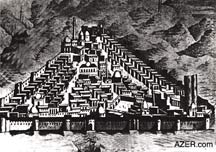  Left: Artist's rendition of Ichari Shahar,
18th century. Note that the citadel wall was separated the land
from intruders attacking from the sea. Left: Artist's rendition of Ichari Shahar,
18th century. Note that the citadel wall was separated the land
from intruders attacking from the sea.
During the past few years, I have collected nearly 1,400 signatures,
mostly from individuals who are living in Ichari Shahar, who
are concerned about the future development in their community.
Here are the major issues:
1. First of
all, buildings should comply with height regulations, meaning
that they should not exceed the historical limit of 11 meters-three
stories. The tallest buildings in Ichari Shahar never used to
exceed this height.
But today, there are quite a few buildings that rise to four
or more stories. This not only affects the visual appearance
of Ichari Shahar, but, in turn, it affects many other aspects
of the city plan as an organic whole.
For example, climatic control is altered. Taller buildings interrupt
the natural flow or channel of air and wind through the streets.
The taller buildings create strong down drafts. Taller buildings
mean a denser population in a section of town that already is
strained by excessive vehicular traffic, and utility infrastructure
related to supplies of water, electric and sewerage.
2. Experts should be consulted in a number of fields to guarantee
that each building is held in compliance with the spirit of the
Old City. These experts should include archaeologists, ecologists,
cartographers, seismologists and geologists, all of whom should
be involved early on in the design of any new construction. In
the past, these experts have not been consulted. Nor have public
photo or video records been kept to document each new building
location before, during and after construction.
3. Construction works should not be carried out with heavy construction
equipment such as excavators, bulldozers and heavy trucks. Our
Constitution demands that historical sites be protected. One
section of the law even prohibits the use of excavating equipment
in such areas.
But these safeguards are not in place. Consideration is not being
made for the layers of civilization that exist under the many
layers of soil; for example, natural springs, underground tunnels
and archaeological artifacts that date back centuries or even
millennia. Some of the new buildings have been constructed in
such a way that they are blocking natural underground water reservoirs.
In earlier times, people knew where these water resources were
located and they dug wells to access clean, cool water. We have
an expression in Azeri that declares that it's a sin to cast
anything into a well. But an even greater sin takes place when
you cover a water supply with rocks or soil. It's like cursing
your native land.
Above: 1&2.Inside view
of the citadel walls which shows how the wall was designed so
that the residents could defend themselves. 3. The Citadel wall
as viewed from Vahid Park nearby the Philarmonic Hall.
Foundations and pilings are being secured by dynamic percussion
works, which again affects underground settlement throughout
the area. Any percussion work carried out on a specific site
has the potential of harming the whole area. This is of particular
concern since the area is prone to earthquakes and landslides.
4. The new buildings are incorporating plastic materials that
are alien to the historical image of the Old City. The "red
lines", meaning the footprints of the buildings, have not
been adhered to and buildings are being expanding beyond the
original building lines. This diverts the natural and historical
patterns of pedestrian and car traffic. Streets that dead-end
have been created where they did not exist before. Again, this
affects the flow of air throughout the neighborhood.
Some buildings now have balconies that protrude beyond the building
façade and thus turn the walkways below into covered passages.
Again, this affects the climactic balance.
5. Archaeological evidence is being destroyed. When excavations
are being done for foundations, archaeological evidence, including
ceramic sewer pipes, underground galleries, tunnels and wells
have been found. Even if you use a spade or shovel to dig, and
if you come across an historical artifact or foundation, you
are required by law to consult with archeologists. They, in turn,
are supposed to judge if you will be allowed to continue your
work or not.
Not only is much of the evidence broken and destroyed during
the construction process, but also no archaeological records
are being made. Archaeologists are not being called to investigate.
Simply, any archaeological evidence that is found is quickly
covered, sometimes even with concrete. Not only does this result
in tremendous historical loss, but also it can affect the drainage
of subsoil water. The additional weight of many of these buildings
is cause for concern because of potential landslides.
6. New construction should be required to have billboards to
identify the design of the new construction. Without such documentation,
the works are likely to be carried out with numerous violations
for construction at a World Heritage site.
7. Often the renovation of the facades of the old buildings is
done with metallic brushes or with sandblasting equipment. This
results in the erosion of the stone surfaces.
These are the basic concerns of our community. The house in which
I live is more than 100 years old. It's a very warm, cozy place.
I don't mean "warm" in the physical sense, but rather
people are conscious of its comfortable, friendly atmosphere.
People who stop by this house even for just 10 minutes don't
want to leave. This is the secret of my house. It's the secret
of Ichari Shahar, too. You come and you want to stay for a long
time. That's what we are fighting so hard to preserve it.
From Azerbaijan
International
(12.3) Autumn 2004.
© Azerbaijan International. All rights reserved.
Back to Index AI 12.3 (Autumn
2004)
AI Home
| Search | Magazine
Choice
| Topics
| AI Store | Contact us
Other Web sites
created by Azerbaijan International
AZgallery.org | AZERI.org | HAJIBEYOV.com
|









